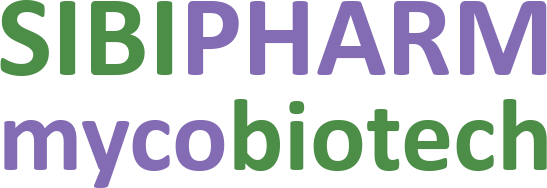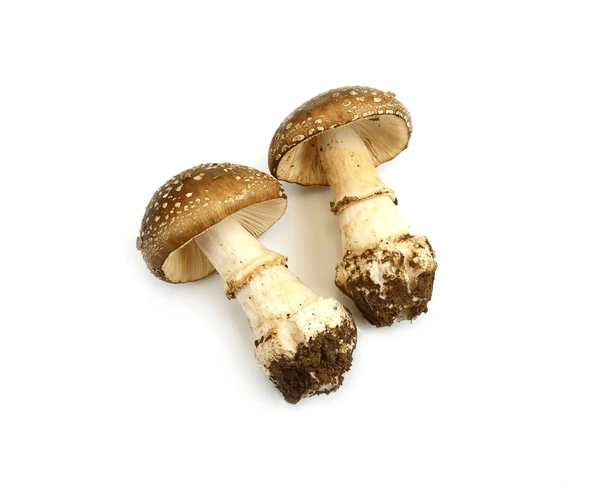Main Applications of Panther Amanita
- Nervous System Regulation.
- Antidepressant Effect.
- Enhancement of Cognitive Function.
- Mood Stabilization.
- Anxiety Reduction.
- Sleep and Wake Modulation.
- Facilitation of Muscle Relaxation.
- Antioxidant Activity.
- Antimicrobial Effect.
- Immune System Modulation.
Mushroom Description
Panther Amanita (Amanita pantherina) is a mushroom with a distinctive light brown cap covered with white warty growths, which are the remains of the general cover of the mushroom. The cap is usually 5-12 cm in diameter, with a smooth surface and easily removable skin. The stem of the mushroom is 5–15 cm high, white, with a distinct ring that often has fringed edges. The flesh of the mushroom is white, does not change color when broken, and has a faint odor.
The mushroom grows mainly in temperate forests, preferring calcareous soils. It is found in Europe, Asia, North America, often in symbiosis with coniferous and deciduous trees. Fruit bodies usually appear in late summer and autumn, when humidity and temperature conditions are most favorable.

This mushroom is often found in clearings, forest edges, and forest paths, where its fruit bodies can be found forming mycorrhizal connections with trees. Despite its toxicity, it sometimes attracts the attention of researchers due to its unique properties.
History of the use of panther fly agaric in treatment
Historically, panther fly agaric was used in shamanic practices and folk medicine of various cultures. In the Far East and Siberia, shamans used it to achieve altered states of consciousness and contact with spirits. Such practices were especially common among the indigenous peoples of Siberia, who considered the fly agaric a means of enhancing spiritual rituals and healing.
Some sources mention the use of panther fly agaric for pain relief and mental disorders. It was used to relieve stress and anxiety, and to treat insomnia. In Japanese and Korean folk medicine, fly agaric was used to fight infections and relieve symptoms of inflammation.
Although Western medicine has long considered fly agarics dangerous, modern research has begun to explore their therapeutic potential. In some European countries, the mushroom was used as a sedative in the 19th century, but its toxicity limited its widespread use. In recent decades, interest in fly agarics has revived in the context of biohacking and alternative methods of treating the nervous system.
Active substances of panther fly agaric
Panther fly agaric contains a number of active substances that determine its effect on the human body. The main active components of the mushroom are isoxazoles, including muscarine, muscimol, ibutenoic acid and muscazone. These compounds affect the central nervous system, causing sedative and psychoactive effects.
Muscimol is the main psychoactive substance of panther fly agaric. It acts as an agonist of GABA receptors, which leads to increased inhibitory processes in the central nervous system. This substance has a pronounced sedative effect, which makes it useful for combating anxiety and sleep disorders.
Ibutenoic acid – this compound is a precursor of muscimol and, when entering the body, is partially converted into it. Ibutenoic acid has a stimulating effect on the central nervous system, but when accumulated, it can lead to sedative effects. Muscarine is a toxic substance that affects the parasympathetic nervous system, causing sweating, salivation, slow heart rate, and other symptoms typical of fly agaric poisoning. Although muscarine is present in small quantities in panther fly agaric, its toxicity must be taken into account.
Muscazone is a less studied compound that is also present in the mushroom and appears to be involved in the overall psychoactive effect. Muscazone can enhance the perception of external stimuli and alter visual perception.
Other components, such as betacarbolines, may affect serotonin levels in the brain, potentially explaining the mushroom’s antidepressant effects. These substances interact with brain receptors, modulating neurotransmitter activity.
Therapeutic effects of panther fly agaric for biohackers
For biohackers, panther fly agaric is of interest due to its effects on the nervous system and psyche. In controlled doses, it can be useful for mood management, stress relief, and cognitive enhancement.
One of the main effects of muscimol is anxiety reduction. It activates GABA receptors, causing relaxation and a sense of calm. Biohackers can use this effect to improve sleep quality and reduce stress, especially in high-stress situations. For example, taking panther mushroom before bed can help a biohacker fall asleep faster and improve sleep quality, which promotes recovery.
Moderation of cognitive function is another important aspect of panther mushroom use. In small doses, muscimol can improve concentration and memory, which is especially useful for biohackers looking to increase their productivity. The psychoactive effects of the mushroom can also stimulate creative thinking and altered states of consciousness, which is important for those who are looking for innovative solutions.
In addition to its psychoactive effects, the mushroom has antioxidant properties, making it useful for protecting the body from oxidative stress. Antioxidants can reduce cell damage and help slow down the aging process, which attracts the attention of biohackers seeking longevity and health optimization.
Panther fly agaric may also have antimicrobial properties. Research shows that some components of the mushroom can inhibit the growth of pathogenic microorganisms, which can be useful for strengthening the immune system.
Do not forget about the ability of the mushroom to modulate the immune system. The active components of panther fly agaric can affect the body’s immune response, which allows it to be used as an additional means of maintaining immunity.
For biohackers, the ability to accurately dose the active substances is important. Despite the toxicity of the mushroom in large doses, with a competent approach and microdosing, panther fly agaric can become a powerful tool for managing your condition and improving the quality of life.
It is important to remember that fly agaric is a toxic mushroom, and its use requires caution and a deep understanding of its mechanisms of action.
Disclaimer:
The information provided in this article is for educational and informational purposes only. It is not intended as a substitute for professional medical advice, diagnosis, or treatment. Never disregard professional medical opinion and consult with a specialist.
Scientific articles:
Jahanabadi S, Amiri S, Karkeh-Abadi M, Razmi A.
Krogsgaard-Larsen P, Brehm L, Schaumburg K.
Johnston GA.
Lee MR, Dukan E, Milne I.






